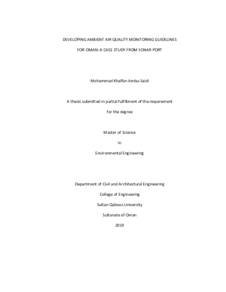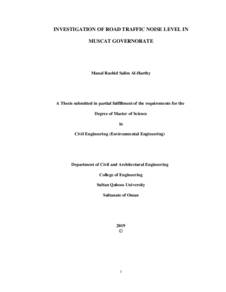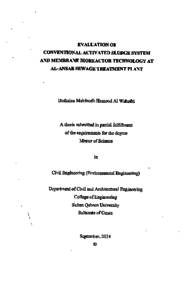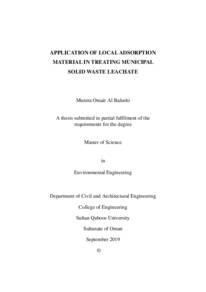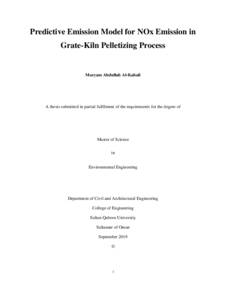Document
Developing ambient air quality monitoring guidelines for Oman: a Case study from Sohar port.
Publisher
Sultan Qaboos University
Gregorian
2019
Language
English
Subject
English abstract
Air quality is a very important environmental and public health issue. Industrialization, urbanization, and transportation are major sources for air pollutions in most cities around the world. Air pollution level in many developing countries is deteriorating due to the fast growing of population and industrialization causing the release of several pollutants into the air. However, to avoid air pollution problems in those countries. They can learn from the developed nations by establishing good control to the air emission to the environment, though high regulation and law to protect it. After MECA's Ministerial Decision 41 /2017 issued, Port and Freezone authority carried out an intensive work to evaluate the impact of industrial activities on the residential area. This model is the first in Oman and for several other authorities within the country, it was worthy to document Sohar port case as a guideline for air quality monitoring network. This study gave a clear problem on air quality management that needs to consider before establishing any monitoring stations. This study outlines the guidelines for carrying out for ambient air
quality monitoring including the selection of monitoring stations, number, and distribution of monitoring stations and some other of the main components. The guidelines have been prepared based on experience gained over the years in ambient air
quality monitoring and management. The report additionally describes quality assurance needs in case any air quality observation.
In recent years, several hundred epidemiological studies have emerged showing adverse health effects associated with short-term and long-term exposure to air pollutants due to the high concentration of particulate matter (PM10), sulfur dioxide (SO2), nitrogen dioxide (NO2), carbon monoxide (CO) and unburned hydrocarbons (UHC). Most of the results of this study from the running of air dispersion model shows the direct effect of the operational processes of the port far below the much allowable limit for carbon monoxide, sulfur dioxide and nitrogen dioxide where 4.1%, 19.32% and 15%, respectively, if we consider the maximum limit to be 100% The statistical indicators to validate the model performances as per US EPA show close
result between the modeled and monitoring data. FB, NMSE, IOA, MG, and VG used for model output validation. IOA for all pollutants except CO was close to the perfect model with a range between (0.53 for PM10 and 0.69 for NO2), the same observed by using FB, MG and VG. The correlation between the modeled number and monitored data show similar trends
over the study period with maximum deviation presentation for PM10, NO2 and SO2 are 25%, 60%, and 31%, respectively.
The dispersion patterns of those pollutants were simulated by employing AERMOD View which is a complete and powerful air dispersion modeling package which seamlessly incorporates the following U.S. EPA air dispersion models into a single integrated
interface with an integrated state of the art meteorological Mesoscale Model (MM5) from 2012 – 2017. The results of this simulation used to quantify the ground level concentrations of all pollutants around the Sohar Port and Freezone.
Member of
Resource URL
Arabic abstract
جودة الهواء هي قضية بيئية وصحية مهمة جدا. يمثل التطور الصناعي والتحضر والنقل مصادر رئيسية للتلوث الهواء في معظم المدن. يتدهور مستوى تلوث الهواء في العديد من البلدان النامية بسبب النمو السريع للسكان الصناعة مما يودي إلى إطلاق العديد من الملوثات في الهواء. ولتجنب مشاكل تلوث الهواء ، يمكن للبلدان النامية أن تتعلم من الدول المتقدمة عن طريق مراقبة جيدة للانبعانات الجوية من مصادرها إلى البيئة ، وعلى الرغم من أن المستويات قد تأثرت تدريجيا خلال التنمية الاقتصادية السريعة للبلدان. وبموجب القرار الوزاري العماني 2017
/ 41 بشأن لائحة جودة الهواء المحيط، قامت إدارة ميناء صحار والمنطقة الحرة بعمل مكثف لتقييم تأثير الأنشطة الصناعية على المنطقة السكنية. هذا النموذج هو الأول من نوعه في سلطنة عمان ولعدة هئيات وإدارات أخرى داخل البلاد ، كان من الجدير توثيق تجرية ميناء صحار كمبدأ توجيهي لشبكة مراقبة جودة الهواء وناقشة هذه الدراسة المشاكل وبوضوح في التعامل و إدارة جودة الهواء والتي يجب أخذها في الاعتبار قبل إنشاء شبكة محطات لرصد جودة الهواء. وذلك من خلال تحديد المواقع الانسب للمحطات والعدد اللازم لكل شبكة والاستخدام الأمثل للمواد المتوفرة لتلية أهداف المراقبة. تختصر هذه الداسية الخطوط لتنفيذ مراقبة جودة الهواء المحيط بما في ذلك اختيار عدد محطات وتوزيعها واختيار الملوثات المراد رصدها لكل محطة وطرق القياس ومدة أخذ العينات. وقد أعدت هذه التوجيهية إستنادا إلى الخيرة المكتسبة عبر السنين في مراقبة وإدارة جودة الهواء المحيط يصف التقرير بالإضافة إلى ذلك ضمان الجودة البيانات المسجلة في المحطات واحتياجات الجوده للمحطة في مراقبة جودة الهواء.
في السنوات الأخيرة ، ظهرت عدة من الدراسات الوبائية تظهر آثارة صحية ضارة مرتبطة بالتعرض على المدى القصير والطويل لتراكيز عالية من ملوثات الهواء بسبب للمواد الجسيمية وثاني أكسيد الكبريت وثاني أكسيد النيتروجين، أول أكسيد الكربون والهيدروكربونات غير المحترقة. تم جمع البيانات الخاصة بالنموذج تشتت الهواء من البيانات المرصده في مداخن لعام 2017. معظم نتائج هذه الدراسة من دراسة تشتت الهواء تظهر تأثير المباشر من العمليات التشغيلة للميناء أقل بكثير من الحد المسموح به للعناصر أول أكسيد الكربون و وثاني أكسيد الكبريت وثاني أكسيد النيتروجين حيث كانت النتائج على النحو الآتي ت 4. 1٪ و 19. 32٪و 15% على التوالي ، إذا اعتبرنا عن الحد الأقصى للملوثات ب 100٪
. تشير المؤثرات الإحصائية للتحقق من صحة أداء النموذج وفقا لوكالة حماية البيئة الأمريكية إلى وجود نتيجة قريبة بين بيانات النموذج والبيانات المرصده بإستخادم أحدى محطات الرصد المحيطه بالميناء. تم استخدام التحيز الجزئي، ومؤشر الاتفاق، والتحيز الوسط الهندني، والتباين المتوسط الهندي للتحقق من صحة نموذج الإخراج. كان مؤشر الاتفاق لجميع الملوثات باستثناء أول أكسدالكربون ، قريب من النموذج المثالي مع نطاق يتراوح بين ( 0. 53 للمواد الجسيمية و 0.69 لثاني أكسيد النيتروجين) ، وهي نفس الملاحظة عند استخدام باقي المؤشرات الإحصائية. وتبين المطابقة بين نتائج النموذج والبيانات المرصده تشابة في المسار مماثلة خلال الفترة ، مع الحد الأقصى لعرض الانحراف عن للمواد الجسيمية و ثاني أكسيد النيتروجين و وثاني أكسيد الكبريت هي ٪25 و 60٪ و 31% على التوالي. تمت محاكاة أنماط التشتت لتلك الملوثات من خلال استخدام برنامج رياضي يحاكي تشتت الهواء وهي حزمة متكاملة وقوية لتشكيل تشتت الهواء ، والتي تضم نماذج الانبعاثات لوكالة حماية البيئة الأمريكية في واجهة واحدة متكاملة مع نموذج متكامل من الأرصاد الجوية في الفتره 2012 - 2017. تم استخدام نتائج هذه المحاكاة لقياس تركيزات مستوى الأرض لجميع الملوثات حول ميناء صحار والمنطقة الحرة.
/ 41 بشأن لائحة جودة الهواء المحيط، قامت إدارة ميناء صحار والمنطقة الحرة بعمل مكثف لتقييم تأثير الأنشطة الصناعية على المنطقة السكنية. هذا النموذج هو الأول من نوعه في سلطنة عمان ولعدة هئيات وإدارات أخرى داخل البلاد ، كان من الجدير توثيق تجرية ميناء صحار كمبدأ توجيهي لشبكة مراقبة جودة الهواء وناقشة هذه الدراسة المشاكل وبوضوح في التعامل و إدارة جودة الهواء والتي يجب أخذها في الاعتبار قبل إنشاء شبكة محطات لرصد جودة الهواء. وذلك من خلال تحديد المواقع الانسب للمحطات والعدد اللازم لكل شبكة والاستخدام الأمثل للمواد المتوفرة لتلية أهداف المراقبة. تختصر هذه الداسية الخطوط لتنفيذ مراقبة جودة الهواء المحيط بما في ذلك اختيار عدد محطات وتوزيعها واختيار الملوثات المراد رصدها لكل محطة وطرق القياس ومدة أخذ العينات. وقد أعدت هذه التوجيهية إستنادا إلى الخيرة المكتسبة عبر السنين في مراقبة وإدارة جودة الهواء المحيط يصف التقرير بالإضافة إلى ذلك ضمان الجودة البيانات المسجلة في المحطات واحتياجات الجوده للمحطة في مراقبة جودة الهواء.
في السنوات الأخيرة ، ظهرت عدة من الدراسات الوبائية تظهر آثارة صحية ضارة مرتبطة بالتعرض على المدى القصير والطويل لتراكيز عالية من ملوثات الهواء بسبب للمواد الجسيمية وثاني أكسيد الكبريت وثاني أكسيد النيتروجين، أول أكسيد الكربون والهيدروكربونات غير المحترقة. تم جمع البيانات الخاصة بالنموذج تشتت الهواء من البيانات المرصده في مداخن لعام 2017. معظم نتائج هذه الدراسة من دراسة تشتت الهواء تظهر تأثير المباشر من العمليات التشغيلة للميناء أقل بكثير من الحد المسموح به للعناصر أول أكسيد الكربون و وثاني أكسيد الكبريت وثاني أكسيد النيتروجين حيث كانت النتائج على النحو الآتي ت 4. 1٪ و 19. 32٪و 15% على التوالي ، إذا اعتبرنا عن الحد الأقصى للملوثات ب 100٪
. تشير المؤثرات الإحصائية للتحقق من صحة أداء النموذج وفقا لوكالة حماية البيئة الأمريكية إلى وجود نتيجة قريبة بين بيانات النموذج والبيانات المرصده بإستخادم أحدى محطات الرصد المحيطه بالميناء. تم استخدام التحيز الجزئي، ومؤشر الاتفاق، والتحيز الوسط الهندني، والتباين المتوسط الهندي للتحقق من صحة نموذج الإخراج. كان مؤشر الاتفاق لجميع الملوثات باستثناء أول أكسدالكربون ، قريب من النموذج المثالي مع نطاق يتراوح بين ( 0. 53 للمواد الجسيمية و 0.69 لثاني أكسيد النيتروجين) ، وهي نفس الملاحظة عند استخدام باقي المؤشرات الإحصائية. وتبين المطابقة بين نتائج النموذج والبيانات المرصده تشابة في المسار مماثلة خلال الفترة ، مع الحد الأقصى لعرض الانحراف عن للمواد الجسيمية و ثاني أكسيد النيتروجين و وثاني أكسيد الكبريت هي ٪25 و 60٪ و 31% على التوالي. تمت محاكاة أنماط التشتت لتلك الملوثات من خلال استخدام برنامج رياضي يحاكي تشتت الهواء وهي حزمة متكاملة وقوية لتشكيل تشتت الهواء ، والتي تضم نماذج الانبعاثات لوكالة حماية البيئة الأمريكية في واجهة واحدة متكاملة مع نموذج متكامل من الأرصاد الجوية في الفتره 2012 - 2017. تم استخدام نتائج هذه المحاكاة لقياس تركيزات مستوى الأرض لجميع الملوثات حول ميناء صحار والمنطقة الحرة.
Category
Theses and Dissertations

